SAUNDERS QUESTIONS AND ANSWERS-NCLEXRN EXAMINATION REVISON CONTENT. Q&A
Document Content and Description Below
SAUNDERS QUESTIONS AND ANSWERS-NCLEX-RN EXAMINATION 1) The nurse is providing discharge instructions to a Chinese American client regarding prescribed dietary modifications. During th e teaching sessi ... on, the client continuously turns away from the nurse. The nurse should implement which best action? 2) A critically ill Hispanic client tells the nurse through an interpreter that she is Roman Catholic and firmly believes in the rituals and traditions of the Catholic faith. Based on the client's statements, which actions by the nurse demonstrate cultural sensitivity and spiritual support? Select all that apply.(1,2,5) 3) Which clients have a high risk of obesity and diabetes mellitus? Select all that apply.(1,2,4,5) 4) The nurse is preparing a plan of care for a client, and is asking the client about religious preferences. The nurse considers the client's religious preferences as being characteristic of a Jehovah's Witness if which client statement is made? 5) The ambulatory care nurse is discussing preoperative procedures with a Japanese American client who is scheduled for surgery the following week. During the discussion, the client continually smiles and nods the head. How should the nurse interpret this nonverbal behavior? 6) When communicating with a client who speaks a different language, which best practice should the nurse implement? Arrange for an interpreter to translate. 7) The nurse educator is providing in-service education to the nursing staff regarding transcultural nursing care; a staff member asks the nurse educator to provide an example of the concept of acculturation. The nurse educator should make which most appropriate response? 8) An Asin American client is experiencing a fever. The nurse plans care so that the client can self-treat the disorder using which method? 9) Which meal tray should the nurse deliver to a client of Orthodox Judaism faith who follows a kosher diet? 10) Which is the best nursing intervention regarding complementary and alternative medicine? 11) An antihypertensive medication has been prescribed for a client with hypertension. The client tells the clinic nurse that he would like to take an herbal substance to help lower his blood pressure. The nurse should take which action? 12) The nurse educator asks a student to list the 5 main categories of complementary and alternative medicine (CAM), developed by the National Center for Complementary and Alternative Medicine. Which statement, if made by the nursing student, indicates a need for further teaching regarding CAM categories? 13) The nurse hears a client calling out for help, hurries down the hallway to the client's room, and finds the client lying on the floor. The nurse performs an assessment, assists the client back to bed, notifies the health care provider of the incident, and completes an incident report. Which statement should the nurse document on the incident report? 14) A client is brought to the emergency department by emergency medical services (EMS) after being hit by a car. The name of the client is unknown, and the client has sustained a severe head injury and multiple fractures and is unconscious. An emergency craniotomy is required. Regarding informed consent for the surgical procedure, which is the best action? 15) The nurse has just assisted a client back to bed after a fall. The nurse and health care provider have assessed the client and have determined that the client is not injured. After completing the incident report, the nurse should implement which action next? 16) The nurse arrives at work and is told to report (float) to the intensive care unit (ICU) for the day because the ICU is understaffed and needs additional nurses to care for the clients. The nurse has never worked in the ICU. The nurse should take which best action? 17) The nurse who works on the night shift enters the medication room and finds a co-worker with a tourniquet wrapped around the upper arm. The co-worker is about to insert a needle, attached to a syringe containing a clear liquid, into the antecubital area. Which is the most appropriate action by the nurse? 18) A hospitalized client tells the nurse that an instructional directive is being prepared and that the lawyer will be bringing the document to the hospital today for witness signatures. The client asks the nurse for assistance in obtaining a witness to the will. Which is the most appropriate response to the client? 18) The nurse has made an error in a narrative documentation of an assessment finding on a client and obtains the client's record to correct the error. The nurse should take which actions to correct the error? Select all that apply. 19) Which identifies accurate nursing documentation notations? Select all that apply. 20) A nursing instructor delivers a lecture to nursing students regarding the issue of client's rights and asks a nursing student to identify a situation that represents an example of invasion of client privacy. Which situation, if identified by the student, indicates an understanding of a violation of this client right? 21) Nursing staff members are sitting in the lounge taking their morning break. An unlicensed assistive personnel (UAP) tells the group that she thinks that the unit secretary has acquired immunodeficiency syndrome (AIDS) and proceeds to tell the nursing staff that the secretary probably contracted the disease from her husband, who is supposedly a drug addict. The registered nurse should inform the UAP that making this accusation has violated which legal tort? 22) An 87-year-old woman is brought to the emergency department for treatment of a fractured arm. On physical assessment, the nurse notes old and new ecchymotic areas on the client's chest and legs and asks the client how the bruises were sustained. The client, although reluctant, tells the nurse in confidence that her son frequently hits her if supper is not prepared on time when he arrives home from work. Which is the most appropriate nursing 23) The nurse calls the heath care provider (HCP) regarding a new medication prescription because the dosage prescribed is higher than the recommended dosage. The nurse is unable to locate the HCP, and the medication is due to be administered. Which action should the nurse take? 24) The nurse employed in a hospital is waiting to receive a report from the laboratory via the facsimile (fax) machine. The fax machine activates and the nurse expects the report, but instead receives a sexually oriented photograph. Which is the most appropriate initial nursing action? 25) The nurse is assigned to care for four clients. In planning client rounds, which client should the nurse assess first? 26) The nurse employed in an emergency department is assigned to triage clients coming to the emergency department for treatment on the evening shift. The nurse should assign priority to which client? 27) A nursing graduate is attending an agency orientation regarding the nursing model of practice implemented in the health care facility. The nurse is told that the nursing model is a team nursing approach. The nurse determines that which scenario is characteristic of the team-based model of nursing practice? 28) The nurse has received the assignment for the day shift. After making initial rounds and checking all of the assigned clients, which client should the nurse plan to care for first? 29) The nurse is giving a bed bath to an assigned client when an unlicensed assistive personnel (UAP) enters the client's room and tells the nurse that another assigned client is in pain and needs pain medication. Which is the most appropriate nursing action? 30) The nurse manager has implemented a change in the method of the nursing delivery system from functional to team nursing. An unlicensed assistive personnel (UAP) is resistant to the change and is not taking an active part in facilitating the process of change. Which is the best approach in dealing with the UAP? 31) The registered nurse is planning the client assignments for the day. Which is the most appropriate assignment for an unlicensed assistive personnel (UAP)? 32) The nurse manager is discussing the facility protocol in the event of a tornado with the staff. Which instructions should the nurse manager include in the discussion? Select all that apply. 33) The nurse employed in a long-term care facility is planning assignments for the clients on a nursing unit. The nurse needs to assign four clients and has a licensed practical (vocational) nurse and 3 unlicensed assistive personnel (UAPs) on a nursing team. Which client would the nurse most appropriately assign to the licensed practical (vocational) nurse? 34) The charge nurse is planning the assignment for the day. Which factors should the nurse remain mindful of when planning the assignment? Select all that apply. 35) The nurse is caring for a client with heart failure. On assessment, the nurse notes that the client is dyspneic, and crackles are audible on auscultation. What additional manifestations would the nurse expect to note in this client if excess fluid volume is present? 36) The nurse is preparing to care for a client with a potassium deficit. The nurse reviews the client's record and determines that the client is at risk for developing the potassium deficit because of which situation? 37) The nurse reviews a client's electrolyte laboratory report and notes that the potassium level is 2.5 mEq/L (2.5 mmol/L). Which patterns should the nurse watch for on the electrocardiogram (ECG) as a result of the laboratory value? Select all that apply. 38) Potassium chloride intravenously is prescribed for a client with hypokalemia. Which actions should the nurse take to plan for preparation and administration of the potassium? Select all that apply. 39) The nurse provides instructions to a client with a low potassium level about the foods that are high in potassium and tells the client to consume which foods? Select all that apply. 40) The nurse is reviewing laboratory results and notes that a client's serum sodium level is 150 mEq/L (150 mmol/L). The nurse reports the serum sodium level to the health care provider (HCP) and the HCP prescribes dietary instructions based on the sodium level. Which acceptable food items does the nurse instruct the client to consume? Select all that apply. 41) The nurse is assessing a client with a suspected diagnosis of hypocalcemia. Which clinical manifestation would the nurse expect to note in the client? 42) The nurse is caring for a client with hypocalcemia. Which patterns would the nurse watch for on the electrocardiogram as a result of the laboratory value? Select all that apply. 43) The nurse reviews the electrolyte results of an assigned client and notes that the potassium level is 5.7 mEq/L (5.7 mmol/L). Which patterns would the nurse watch for on the cardiac monitor as a result of the laboratory value? Select all that apply. 44) Which client is at risk for the development of a sodium level at 130 mEq/L (130 mmol/L)? 45) The nurse is caring for a client with heart failure who is receiving high doses of a diuretic. On assessment, the nurse notes that the client has flat neck veins, generalized muscle weakness, and diminished deep tendon reflexes. The nurse suspects hyponatremia. What additional signs would the nurse expect to note in a client with hyponatremia? 46) The nurse reviews a client's laboratory report and notes that the client's serum phosphorus (phosphate) level is 1.8 mg/dL (0.45 mmol/L). Which condition most likely caused this serum phosphorus level? 47) The nurse is reading a health care provider's (HCP's) progress notes in the client's record and reads that the HCP has documented "insensible fluid loss of approximately 800 mL daily." The nurse makes a notation that insensible fluid loss occurs through which type of excretion? 48) The nurse is assigned to care for a group of clients. On review of the clients' medical records, the nurse determines that which client is most likely at risk for a fluid volume deficit? 49) The nurse caring for a client who has been receiving intravenous (IV) diuretics suspects that the client is experiencing a fluid volume deficit. Which assessment finding would the nurse note in a client with this condition? 50) On review of the clients' medical records, the nurse determines that which client is at risk for fluid volume excess? 51) Which client is at risk for the development of a potassium level of 5.5mEq/L (5.5 mmol/L)? 52) The nurse reviews the arterial blood gas results of a client and notes the following: pH 7.45, Paco2 of 30 mm Hg (30 mm Hg), and HCO3– of 20 mEq/L (20 mmol/L). The nurse analyzes these results as indicating which condition? 53) The nurse is caring for a client with a nasogastric tube that is attached to low suction. The nurse monitors the client for manifestations of which disorder that the client is at risk for? 54) A client with a 3-day history of nausea and vomiting presents to the emergency department. The client is hypoventilating and has a respiratory rate of 10 breaths/minute. The electrocardiogram (ECG) monitor displays tachycardia, with a heart rate of 120 beats/minute. Arterial blood gases are drawn and the nurse reviews the results, expecting to note which finding? 55) The nurse is caring for a client having respiratory distress related to an anxiety attack. Recent arterial blood gas values are pH = 7.53, Pao2 = 72 mm Hg (72 mm Hg), Paco2 = 32 mmHg (32 mm Hg), and HCO3– = 28 mEq/L (28 mmol/L). Which conclusion about the client should the nurse make? 56) The nurse is caring for a client with diabetic ketoacidosis and documents that the client is experiencing Kussmaul's respirations. Which patterns did the nurse observe? Select all that apply. 57) A client who is found unresponsive has arterial blood gases drawn and the results indicate the following: pH is 7.12, Paco2 is 90 mm Hg (90 mm Hg), and HCO3– is 22 mEq/L (22 mmol/L). The nurse interprets the results as indicating which condition? 58) The nurse notes that a client's arterial blood gas (ABG) results reveal a pH of 7.50 and a Paco2 of 30 mm Hg (30 mm Hg). The nurse monitors the client for which clinical manifestations associated with these ABG results? Select all that apply. 59) The nurse reviews the blood gas results of a client with atelectasis. The nurse analyzes the results and determines that the client is experiencing respiratory acidosis. Which result validates the nurse's findings? 60) The nurse is caring for a client who is on a mechanical ventilator. Blood gas results indicate a pH of 7.50 and a Paco2 of 30 mm Hg (30 mm Hg). T [Show More]
Last updated: 3 years ago
Preview 1 out of 15 pages
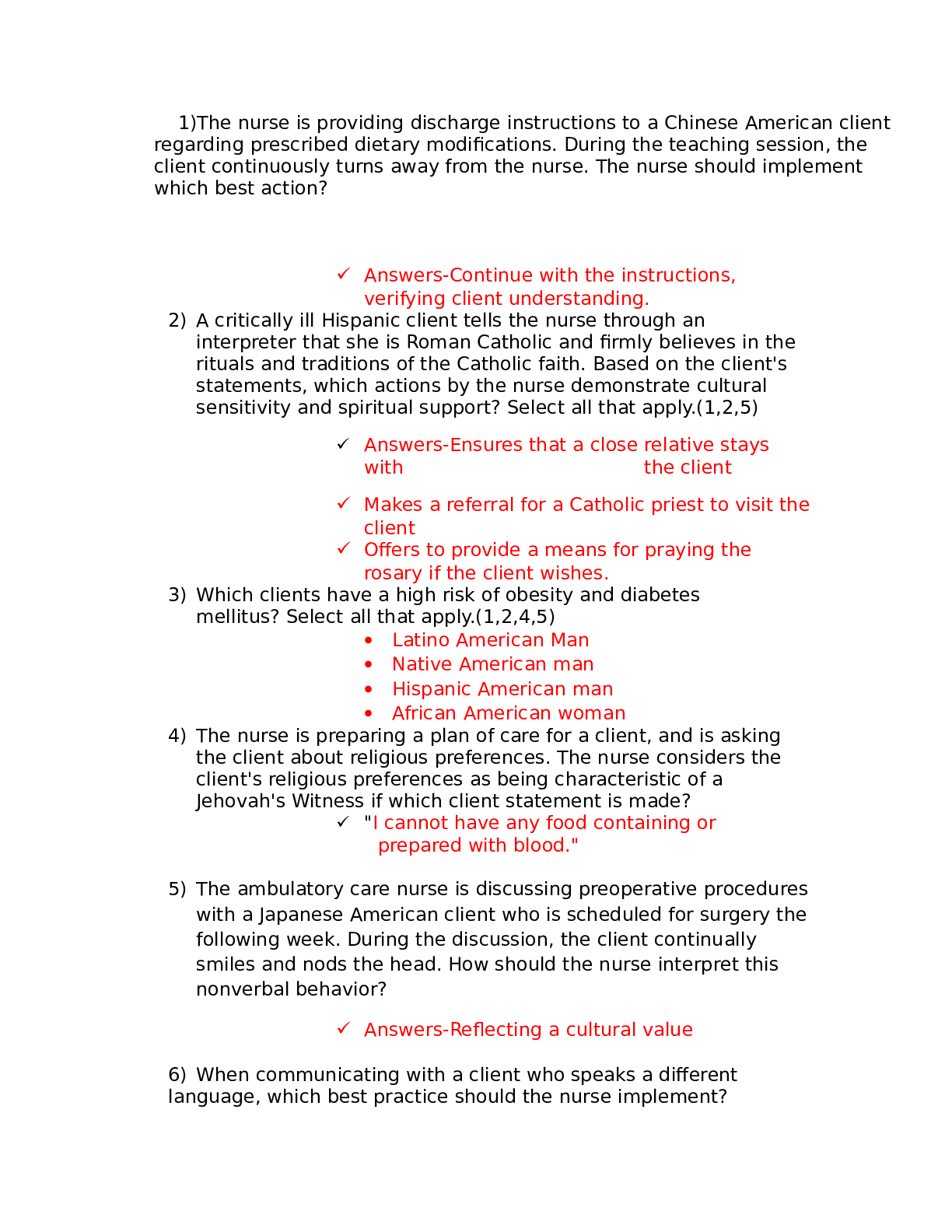
Buy this document to get the full access instantly
Instant Download Access after purchase
Buy NowInstant download
We Accept:

Reviews( 0 )
$5.00
Can't find what you want? Try our AI powered Search
Document information
Connected school, study & course
About the document
Uploaded On
Aug 08, 2021
Number of pages
15
Written in
All
Additional information
This document has been written for:
Uploaded
Aug 08, 2021
Downloads
0
Views
90

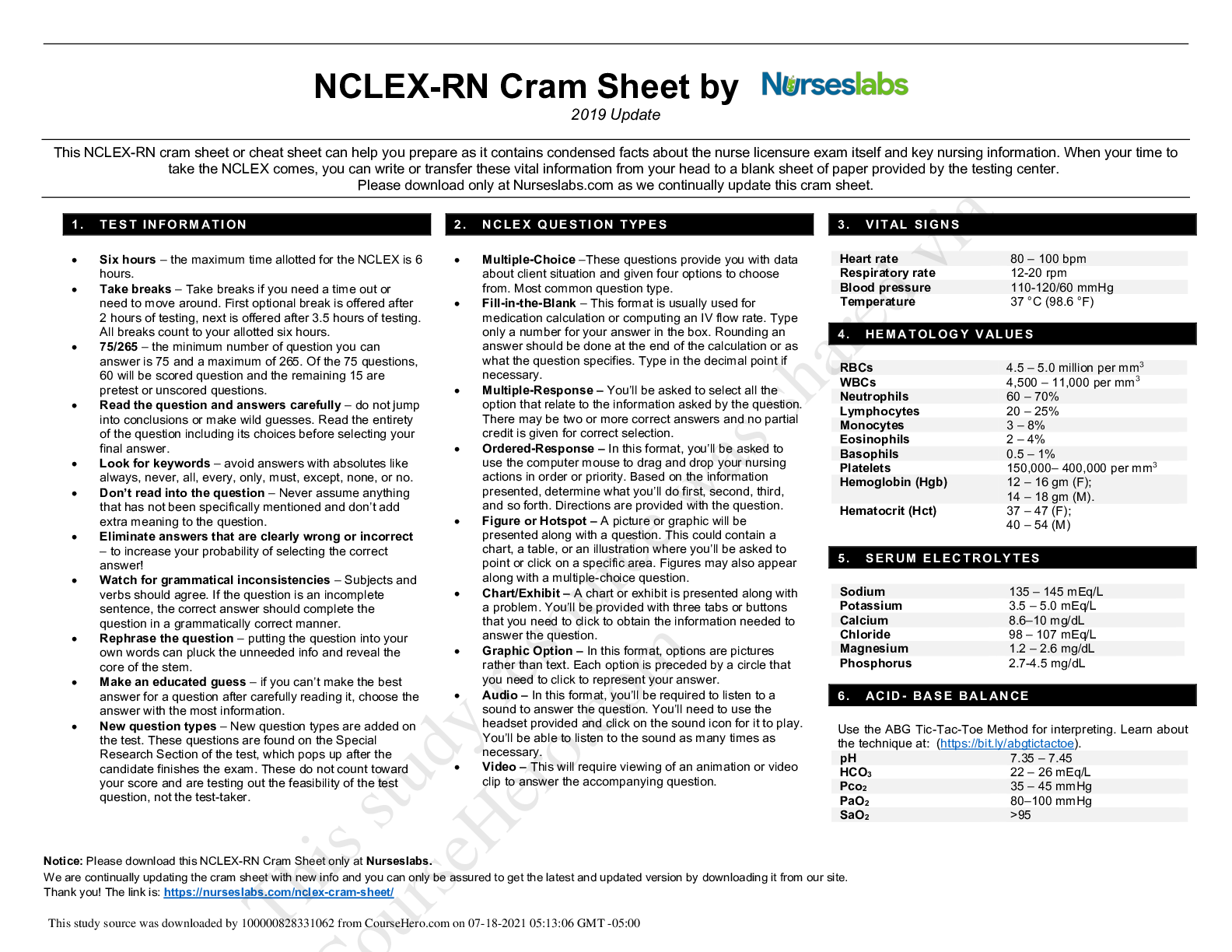
.png)

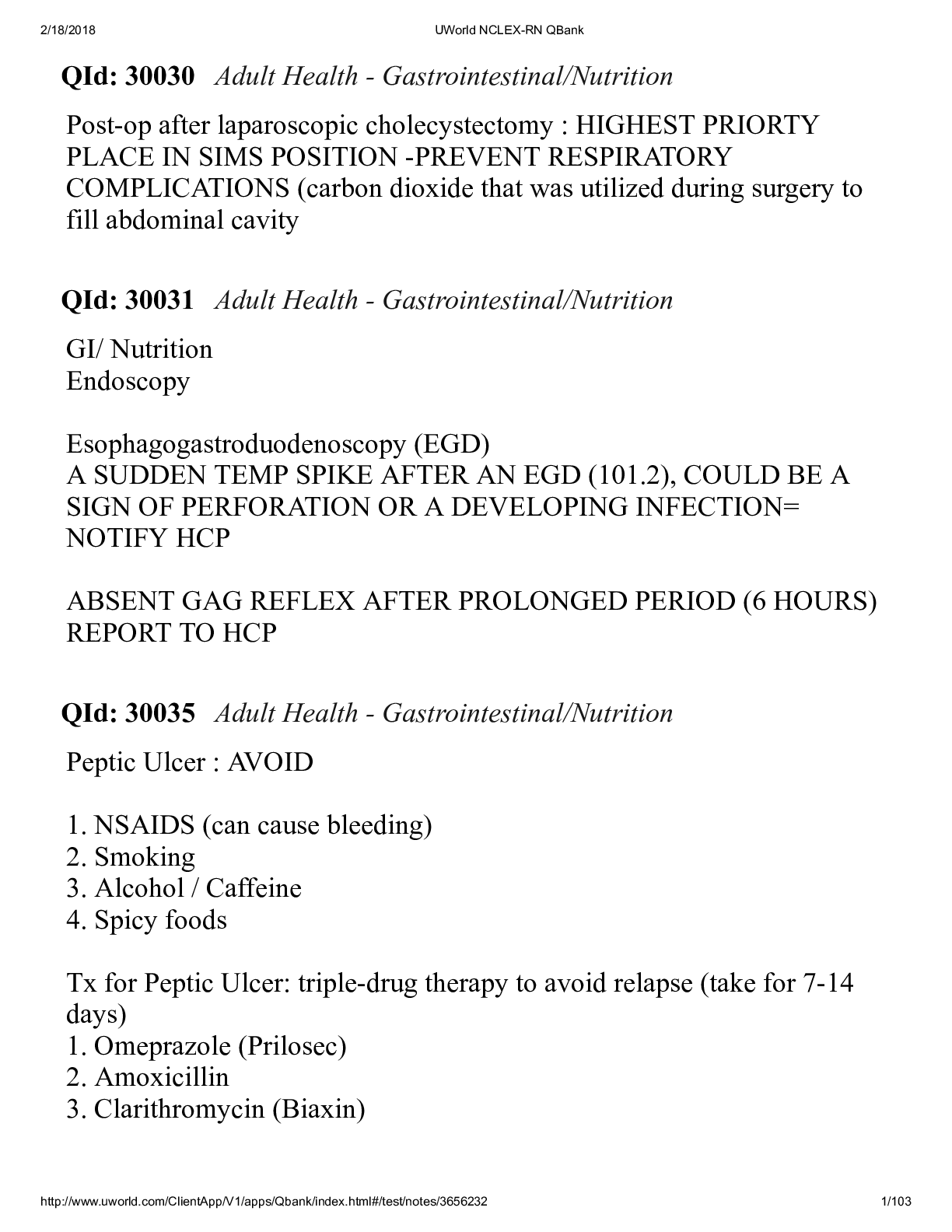


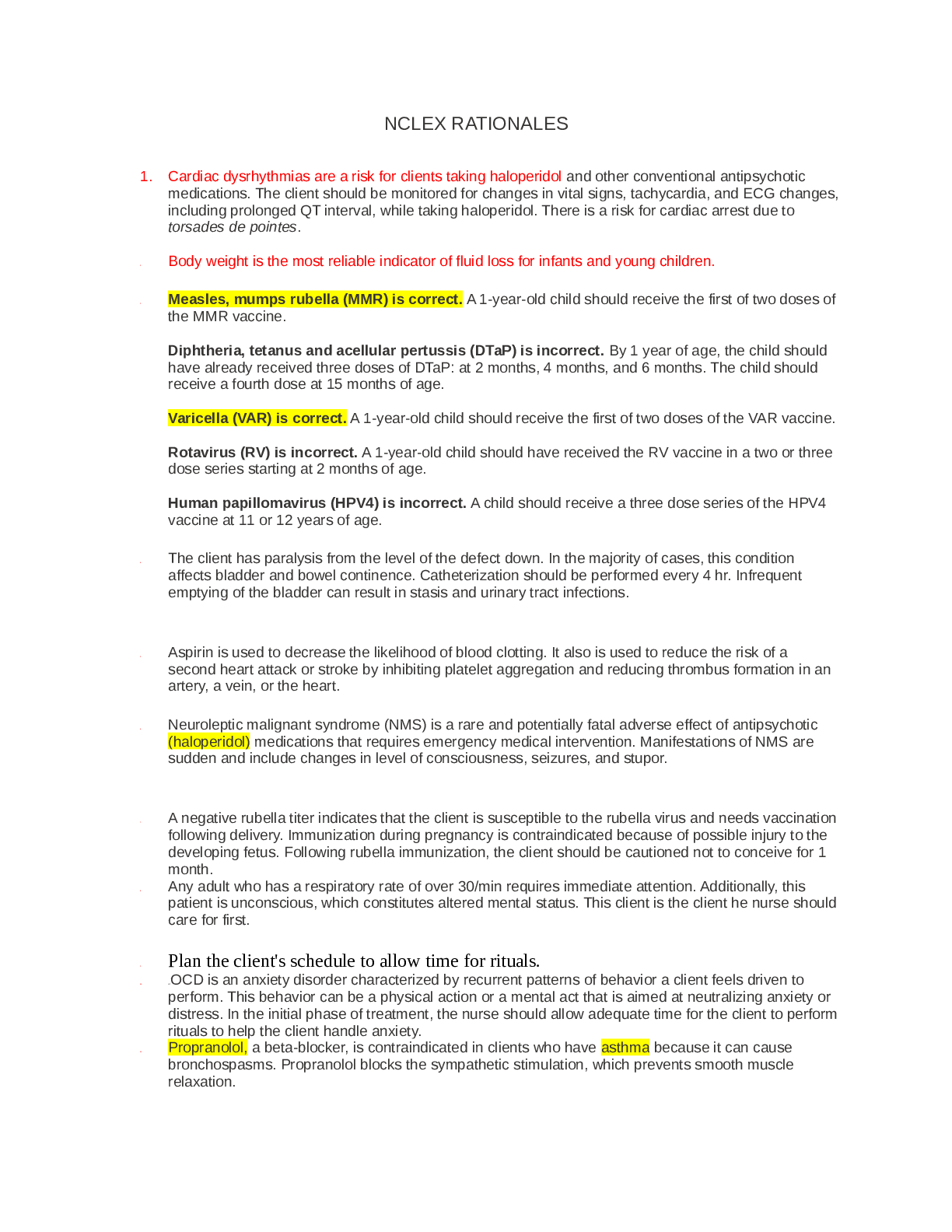

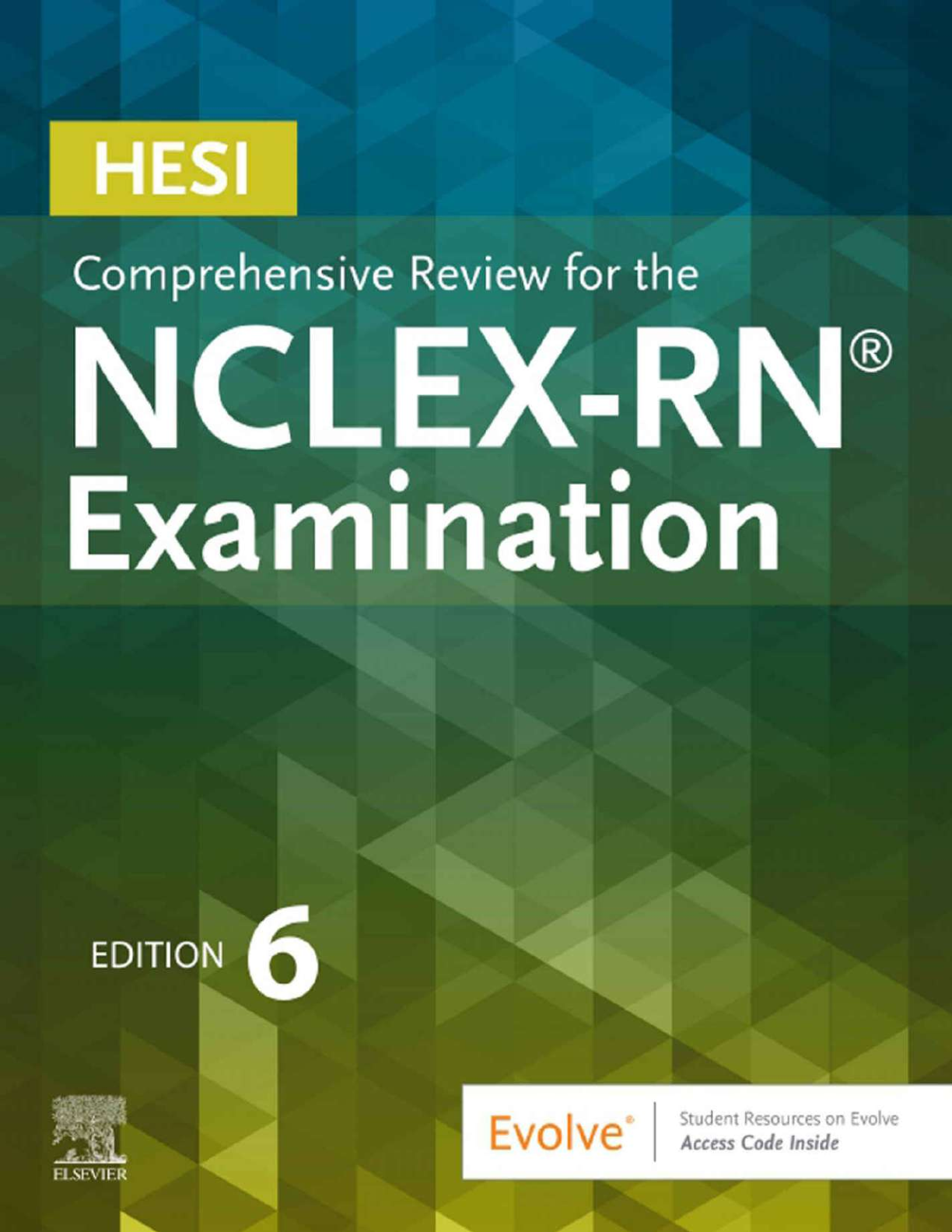

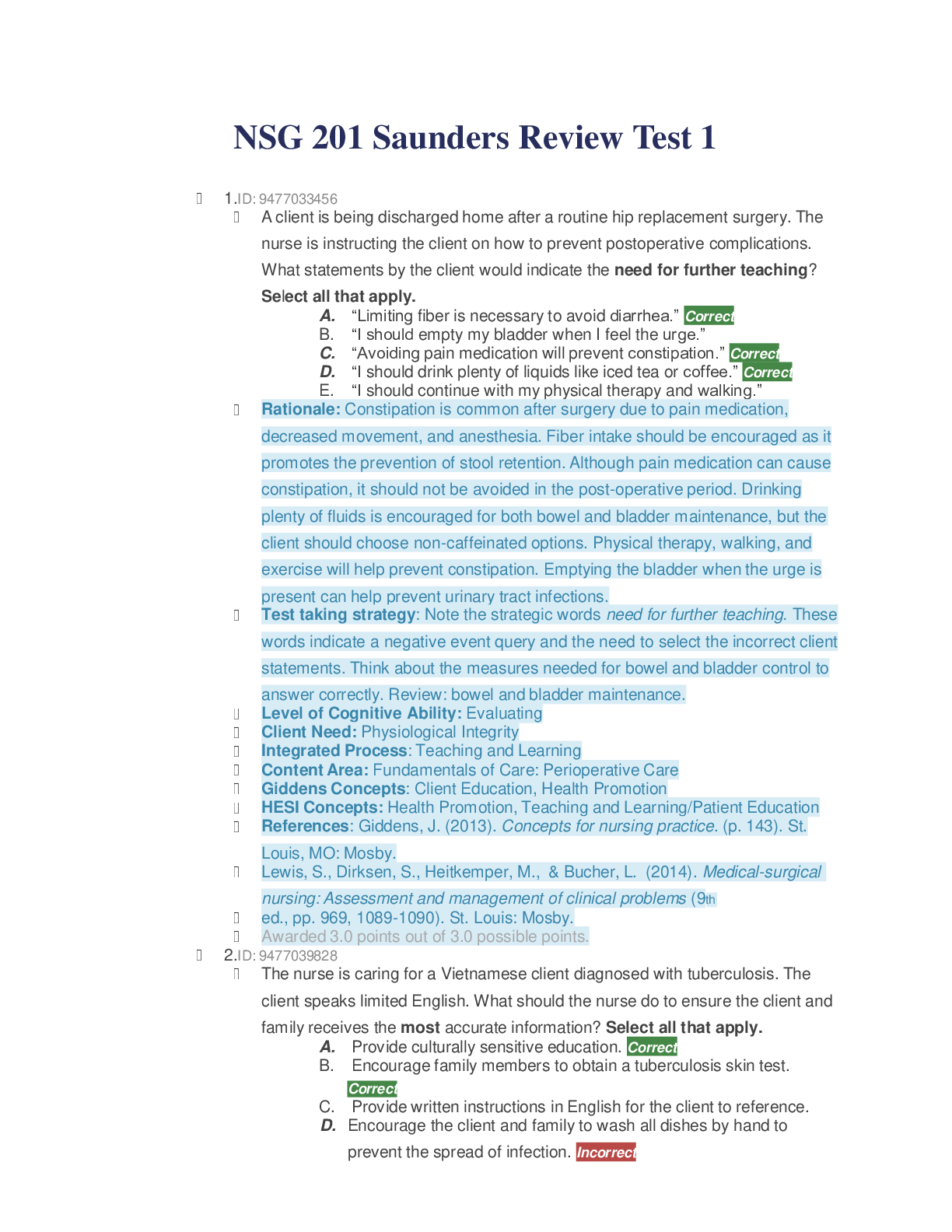
NCLEX.png)


